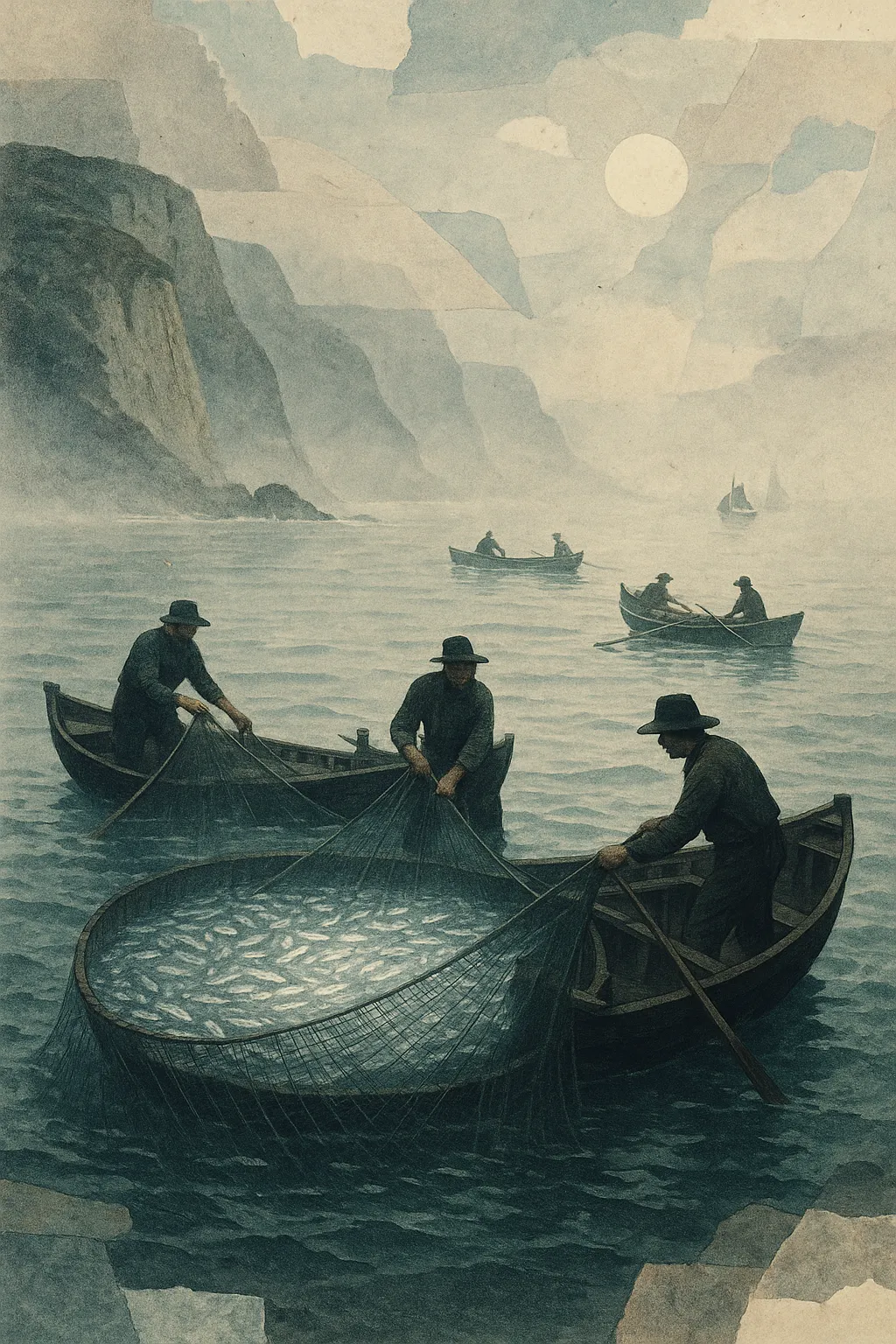
The Silver Harvesters
(Cornish Pilchard Fishermen, 18th–19th Century)
On the western edge of England, where the cliffs of Cornwall break the Atlantic into mist, an old economy once shimmered in silver. Each summer, entire villages turned toward the sea, waiting for the faint flash of light that meant the pilchards had come.
The Cry from the Cliffs
From the high headlands, men known as huers kept watch. Wrapped in rough wool and patience, they scanned the bays for a sudden gleam, a shifting tone on the surface of the water, the color of quicksilver under cloud. When they saw it, they cupped their hands and shouted,
“Hevva! Hevva!”
The cry spread like lightning. Boats were dragged to the surf, nets were readied, and oars locked into tholes polished by generations of palms. Out went the seine boats, long narrow vessels crewed by men who had learned to read tide, light, and the invisible language of fish.
The sea would boil with silver bodies, tens of thousands of pilchards moving as one. Nets drew in circles that glittered in moonlight, and the men strained against the ropes until their shoulders burned.
For a brief, radiant moment, Cornwall was a center of the world.
The Women of the Salt
On shore, another rhythm unfolded, quieter but no less fierce. Women stood in rows in the curing houses, layering fish and salt in tall wooden barrels. They wore aprons soaked in brine, their hair threaded with the smell of sea and smoke. The work songs they sang, part Cornish keening and part chapel hymn, carried down to the harbor, meeting the cries of gulls and the slap of waves.
The pilchards were pressed under stones for weeks, the oil running down narrow channels into collection pots. That oil lit lamps across Europe. The cured fish themselves, known abroad as Cornish sardines or pesce inglese, were shipped by the thousands to Catholic countries where abstinence from meat had made fish a kind of sacred staple.
Italy, France, and Spain became the silent partners of this small Atlantic peninsula.
An Economy of Faith and Folklore
By the late 1700s, the pilchard fishery employed tens of thousands of people, not only fishermen and salters but also coopers, boatbuilders, merchants, and exporters. In villages like St Ives, Mevagissey, and Newlyn, the smell of curing hung over the streets year-round.
Superstition governed everything. A woman crossing the path before a boat launch meant bad luck. A red-haired visitor at dawn meant the shoals would scatter. Sundays were for chapel, but the sea remained the truer church.
The pilchard itself became both providence and parable, a symbol of divine timing. The entire economy pulsed on migration: fish following unseen currents, and men following fish. When the shoals failed, famine rippled through the region.
Decline of the Silver Tide
The early 1800s brought the first murmurs of change. Herring fisheries grew dominant, pilchard shoals began to thin. Some blamed overfishing, others foreign competition, and some, in letters preserved at the Royal Cornwall Museum, blamed simply "the Lord’s turning of the tide."
By the 1880s, the great pilchard runs were memories. Many curing cellars were abandoned or converted to artists’ studios as Cornwall reinvented itself as a place of light and painters rather than salt and labor.
Yet the echoes endure. The old pilchard presses still stand in Polperro and Mevagissey, and a few barrels are filled each year as demonstration. The Cornish word hevva lingers in the name of Hevva Cake, a raisin-spiced pastry said to commemorate the huers’ call.
In some harbors, you can still hear the wind whistle through old chimneys as if repeating a long-forgotten signal from the cliffs.
The Memory Beneath the Waves
Modern oceanographers note that pilchard populations still shift cyclically with temperature and plankton abundance, their migrations tracing invisible lines of climate rather than fate. What was once myth now reads as early ecological observation: the fishermen were, unknowingly, tracking the oscillations of the North Atlantic itself.
But numbers cannot hold what the people once felt, the unity of village, sea, and sky in one luminous instant of abundance.
On calm evenings, locals say the ocean still flashes with light just before dusk.
Not the return of fish, perhaps, but memory itself,
a glimmer of generations who lived by the shimmer of the sea,
their voices fading into the wind’s old word:
Hevva.
Primary sources:
Cornwall Heritage Trust: The Cornish Pilchard Industry
National Maritime Museum Cornwall archives
British Library oral history collections